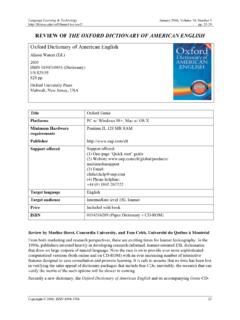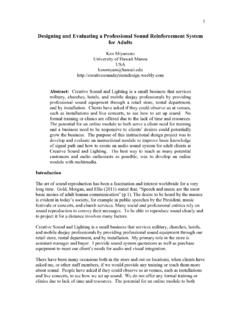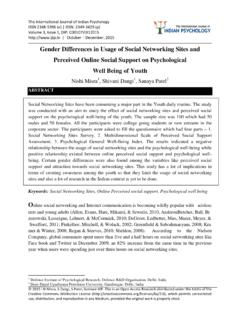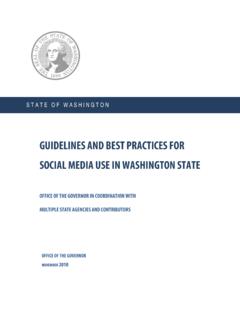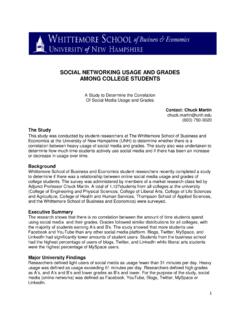Transcription of Usage of Social Media Systems in Customer Service Strategies
1 Usage of Social Media Systems in Customer Service Strategies Alexander Rossmann Reutlingen University @ Tim Wilke Reutlingen University @ Gerald Stei Reutlingen University @ This paper examines the efficacy of Social Media Systems in Customer complaint handling. The emergence of Social Media , as a useful complement and (possibly) a viable alternative to the traditional channels of Service delivery, motivates this research. The theoretical framework, developed from literature on Social Media and complaint handling, is tested against data collected from two different channels (hotline and Social Media ) of a German telecommunication services provider, in order to gain insights into channel efficacy in complaint handling. We contribute to the understanding of firm s technology Usage for complaint handling in two ways: (a) by conceptualizing and evaluating complaint handling quality across traditional and Social Media channels and (b) by comparing the impact of complaint handling quality on key performance outcomes such as Customer loyalty, positive word-of-mouth, and cross-purchase intentions across traditional and Social Media channels.
2 1. Introduction Customer complaints are recurrent and complaint handling is an important indicator of a firm s Customer centricity and overall Service quality [1]. Barring a few studies that examined firm success rate and the cost involved in such decisions [2], the use of Social Media Systems in Customer complaint handling services remains largely unexplored. We examine whether firms are better off using Social Media as part of their channel strategy for handling Customer complaints by comparing them with traditional channels. Firms are adopting Social Media as part of their communication Strategies [3]. This includes multiple decisions, Usage of platforms like Facebook and Twitter, implementation of Social Media monitoring software, and internal processes. Therefore, Social Media is not just an additional channel.
3 Moreover, the implementation of Social Media as a Service and marketing strategy leads to a system of decisions, processes, and technologies. In a Customer Service context, Social Media helps firms to analyze Customer online communication, identify Service issues at an early stage, create satisfying Service experiences, and provide customers with a direct and convenient way to share their sentiments by electronic word-of-mouth. Research evidence suggests that companies which complement their Service strategy with Social Media Systems are more successful [4, 5]. However, considerable costs are involved in the implementation of new communication Systems [2], and channel expansion decisions have a long-term impact on a firm s performance [6]. In short, whether firms are better off using Social Media Systems or not remains an open question.
4 Comparing the performance of Social Media against traditional channels, this study examines the concept of perceived complaint handling quality (PCHQ), conceptualized as the complainer s subjective assessment of the complaint handling Service [7]. Therefore, we address three open questions of interest: (a) how should PCHQ be conceptualized across different channels?; (b) how strong are the effects of different facets of PCHQ on Customer satisfaction and other key performance outcomes?; and (c) how effective are Social Media channels as compared to traditional channels for Customer complaint handing? To answer these research questions, we followed a three-step approach: (a) a literature review of complaint handling and Service recovery research, (b) collecting supporting evidence from a survey of customers and marketing executives across traditional and Social Media channels, (c) an empirical comparison of the research model using Customer -level data collected in an online survey.
5 Our findings illustrate that it is not always in the firm s best interest to use feature-rich channels such as Social Media . Though use of Social Media Systems is expected to improve the quality of solutions and reduce Customer effort, their marginal impact on satisfaction and subsequently on behavioral intentions is lower than traditional Media . In sum, we contribute to the understanding of firm s channel strategy for complaint handling in two ways: (a) by evaluating complaint handling quality across different channels and (b) by comparing the impact of complaint handling quality on 3950 Proceedings of the 50th Hawaii International Conference on system Sciences | 2017 URI: : 978-0-9981331-0-2CC-BY-NC-NDkey performance outcomes such as Customer loyalty, positive word-of-mouth, and cross-purchase intentions across traditional and Social Media channels.
6 2. Complaint Handling Early studies of complaint management [8, 9] agreed that the Customer s perception of fairness in complaint handling has three distinct dimensions, distributive, procedural, and interactional justice. This three-dimensional structure was theorized and tested in a meta-analytic framework proposed by Orsingher et al. [10]. Distributive justice refers to Customer perception regarding the firm s effort to correct the observed problem [11]. Procedural justice refers to how the complainant perceives the procedure of decision making and conflict resolution undertaken by the firm. A procedurally fair complaint handling process is easy to access, provides Customer control over its disposition, is flexible, and concludes in an appropriate and timely manner [12].
7 Interactional justice refers to the behavior of employees during the complaint handling process. It is associated with the employee s empathy, politeness, treatment, and related efforts to make up for the complaint [12, 13]. However, recent studies have questioned the distinctness of these three justice dimensions [14]. Several studies integrate the dimensions and treat them as a single construct, due to high correlation between the dimensions [15]. Given the conflicting findings around the dimensionality of PCHQ, we derive the initial conceptualization of PCHQ based on a review of the current literature that accumulated possible lines of evidence (or descriptive codes) in a spreadsheet. Thereafter, these codes were interpreted and synthesized to yield 15 distinct facets of PCHQ, which were iteratively segregated into five coherent dimensions.
8 The three dimensions of perceived justice plus, a fourth dimension for the quality of the core Service solution emerged. The fifth dimension was an outcome of splitting the construct of distributive justice into two lower-level constructs one due to the general evaluation of fairness during the complaint handling process, and another for the perception of the effort customers are willing to make in order to resolve a complaint. We used these 15 facets in an exploratory survey of managers and consumers to ensure further robustness. Data was collected across the 15 facets of PCHQ from a three-part sample, comprising both customers and Service providers across a multi-channel context of Social Media and traditional channels. The three different samples included a group of Service agents plus two groups of consumers (one each from Social Media (Facebook and Twitter) and traditional Service channels (hotline).)
9 The sample was drawn from a list of marketing executives and customers of a telecommunication Service provider in Germany. The firm operates its own Service community on Facebook, as well as a special complaint handling account on Twitter, as part of its corporate strategy for effectively dealing with Service complaints. The customers of this provider also receive complaint handling services through traditional channels such as hotline, shops, and letters. The presentation of the results of this exploratory evaluation phase goes beyond the available scope of this paper. However, Figure 1 shows the identified five subdimensions of PCHQ as (a) procedural justice, (b) interactional justice, (c) distributive justice, (d) Customer effort, and (e) quality of Service solutions.
10 We integrate these facets of PCHQ and anchor them in expectation disconfirmation theory with a view to modeling Customer satisfaction as a mediator of the impact of PCHQ on three key performance outcomes ( Customer loyalty, word-of-mouth, and cross-purchase preferences). Additionally, the main effects are tested for a possible moderating role for the type of Service channel ( Social Media vs. hotline). 3951 Figures indicate the respective R2 values EG = Empirical generalization; H = Hypotheses Figure 1. Conceptual Framework 3. Conceptual Framework and Hypotheses As our focus is to understand PCHQ and how its dimensions vary in strength across the two types of channels, we hypothesize in detail those aspects that have not been tested in prior research and might not necessarily generalize along the two channels.

